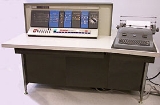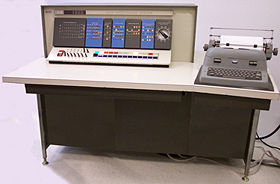
IBM 1620 Model I
Encyclopedia
The IBM 1620 Model I was the original implementation of the IBM 1620
scientific computer, introduced in 1959.
This unit (commonly called "1620" until the Model II
was introduced) was produced as inexpensively as IBM could make it, in order to keep the price low. One industry magazine (Datamation
) mentioned that the 1620 was the first IBM computer for which the basic system could be leased for a monthly rate less than its number.
It did not even have conventional ALU hardware: all arithmetic was done by table lookup in core memory. Addition and Subtraction used a 100 digit table (@ address 00300..00399). Multiplication used a 200 digit table (@ address 00100..00299). In the basic machine division used software subroutines, but optional divide hardware could be installed using a repeated subtraction algorithm. Floating point arithmetic instructions were an available option (if the divide option was installed).
The console typewriter was a modified Model B1
, which typed at only 10 characters per second. (This typewriter had a very 'nasty' habit of breaking off its "0" hammer and throwing it across the room in the middle of a long core dump
!)
The first 20,000 decimal digits of Core memory were internal to the CPU
itself (which reduced the floor space requirements of the basic system). Expansion to either 40,000 or 60,000 decimal digits required the addition of an IBM 1623 Memory unit. The Memory cycle time was 20μs
(i.e., the memory speed was 50kHz = 1/20th of a MHz). A Memory Address Register Storage (MARS) Core memory read, clear, or write operation took 2μs and each write operation was automatically (but not necessarily immediately) preceded by a read or clear operation of the same "register(s)" during the 20μs Memory cycle.
The central processor clock speed was 1MHz, which was divided by 20 by a 10 position ring counter
to provide the system timing/control signals.
Instructions took 8 Memory cycles (160μs) to fetch and a variable number of Memory cycles to execute. Indirect addressing added 4 Memory cycles (80μs) for each level of indirection.
IBM 1620
The IBM 1620 was announced by IBM on October 21, 1959, and marketed as an inexpensive "scientific computer". After a total production of about two thousand machines, it was withdrawn on November 19, 1970...
scientific computer, introduced in 1959.
This unit (commonly called "1620" until the Model II
IBM 1620 Model II
The IBM 1620 Model II was a vastly improved implementation, compared to the original Model I, of the IBM 1620 scientific computer architecture....
was introduced) was produced as inexpensively as IBM could make it, in order to keep the price low. One industry magazine (Datamation
Datamation
Datamation was a print computer magazine published in the United States between 1957 and 1998. When first published it wasn't clear there would be a significant market for a computer magazine given how few computers there were...
) mentioned that the 1620 was the first IBM computer for which the basic system could be leased for a monthly rate less than its number.
It did not even have conventional ALU hardware: all arithmetic was done by table lookup in core memory. Addition and Subtraction used a 100 digit table (@ address 00300..00399). Multiplication used a 200 digit table (@ address 00100..00299). In the basic machine division used software subroutines, but optional divide hardware could be installed using a repeated subtraction algorithm. Floating point arithmetic instructions were an available option (if the divide option was installed).
 |
| IBM 1620 Model I Level H, running. |
| Drawing showing internal layout of "gates". |
The console typewriter was a modified Model B1
IBM Electric typewriter
The IBM Electric typewriters were a series of electric typewriters that IBM manufactured, starting in the mid-1930s. They used the conventional moving carriage and typebar mechanism, as opposed to the fixed carriage and type ball used in the IBM Selectric, introduced in 1961...
, which typed at only 10 characters per second. (This typewriter had a very 'nasty' habit of breaking off its "0" hammer and throwing it across the room in the middle of a long core dump
Core dump
In computing, a core dump consists of the recorded state of the working memory of a computer program at a specific time, generally when the program has terminated abnormally...
!)
The first 20,000 decimal digits of Core memory were internal to the CPU
Central processing unit
The central processing unit is the portion of a computer system that carries out the instructions of a computer program, to perform the basic arithmetical, logical, and input/output operations of the system. The CPU plays a role somewhat analogous to the brain in the computer. The term has been in...
itself (which reduced the floor space requirements of the basic system). Expansion to either 40,000 or 60,000 decimal digits required the addition of an IBM 1623 Memory unit. The Memory cycle time was 20μs
Microsecond
A microsecond is an SI unit of time equal to one millionth of a second. Its symbol is µs.A microsecond is equal to 1000 nanoseconds or 1/1000 millisecond...
(i.e., the memory speed was 50kHz = 1/20th of a MHz). A Memory Address Register Storage (MARS) Core memory read, clear, or write operation took 2μs and each write operation was automatically (but not necessarily immediately) preceded by a read or clear operation of the same "register(s)" during the 20μs Memory cycle.
The central processor clock speed was 1MHz, which was divided by 20 by a 10 position ring counter
Ring counter
A ring counter is a type of counter composed of a circular shift register. The output of the last shift register is fed to the input of the first register.There are two types of ring counters:...
to provide the system timing/control signals.
Instructions took 8 Memory cycles (160μs) to fetch and a variable number of Memory cycles to execute. Indirect addressing added 4 Memory cycles (80μs) for each level of indirection.
Non-decimal arithmetic
It is commonly believed that since this model used lookup tables in memory that simply changing the contents of these tables allowed the programmer to do arithmetic in any base from 2 to 10. This is only partially true as the hardware included a ten's complementer for subtraction (and addition of oppositely signed numbers). Therefore only addition of unsigned numbers could be correctly performed in bases 5 to 9. To do fully signed addition and subtraction in bases 2 to 4 required detailed understanding of the hardware to create a "folded" addition table that would fake out the complementer and carry logic. Also the addition table would have to be reloaded for normal base 10 operation every time address calculations were required in the program, then reloaded again for the alternate base. This made the "trick" somewhat less than useful for any practical application.Upper console
- Instruction and Execute Cycle – 60 lamps
- Control Gates – 35 lamps
- Input-Output – 15 lamps
- Operation Register – 25 lamps
- Memory Buffer Register – 30 lamps
- Memory Address Register – 25 lamps
- Memory Address Register Display Selector – Rotary switch, 12 positions
Lower console
- Emergency Off Pull – Pull switch
- Check Condition status lamps/switches – 15 lamps & 5 toggle switches
- Program Switches – 4 toggle switches
- Console operator lights/switches – 13 lights, 1 power switch, and 12 buttons

